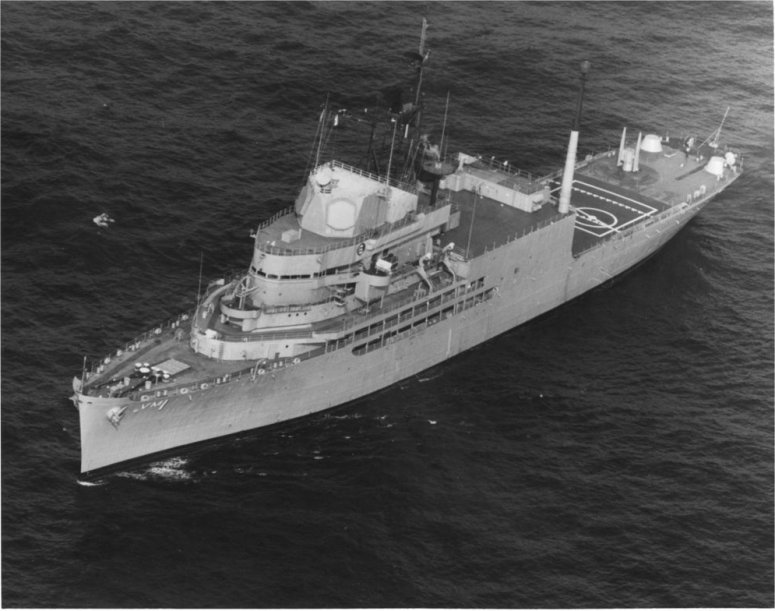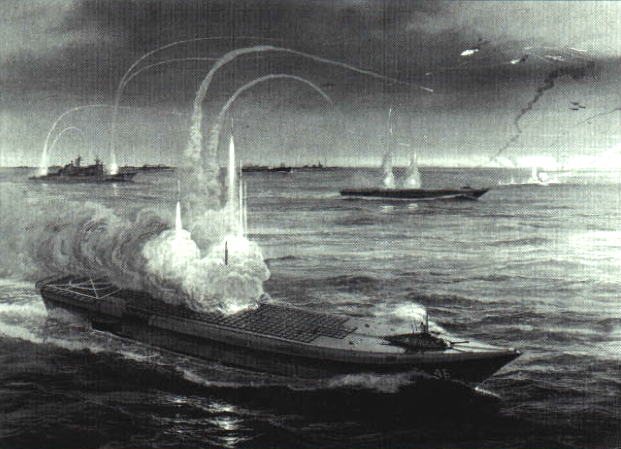By 1960, the age of the battleship was clearly over. Not a single one remained in active service anywhere in the world, although some of the treaty battleships still lingered on in reserve fleets. But while they were clearly outdated in fleet combat, the presence of such large, fast, and relatively young hulls drew interest for a variety of purposes.

Iowa as a Commando Ship (from Shipbucket)
One particular area of interest was an amphibious conversion. With the end of WWII and the advent of the atomic bomb, amphibious warfare was undergoing major changes, and the idea of turning a battleship into a helicopter carrier held some appeal. An early plan for the North Carolina class foundered when it was found to be more expensive and less efficient than a new-build ship, but plans for the Iowas, under the name "commando ship", lasted much longer. The basic idea was to disperse the amphibious force across more ships, to reduce vulnerability to nuclear attack, and to get the 16" guns back to sea to provide fire support, including the Mk 23 nuclear shell.
The basic idea was to remove Turret III and all but the forward two 5" turrets, and replace it with a new superstructure that included facilities for helicopters, landing craft, and troops. The flight deck and hangar would have accommodated 20 CH-46 helicopters, with 16 LCMs stored alongside the stacks and a Marine battalion of 1,800 troops billeted somewhere in the new structure. Because the commando ship was intended to operate semi-independently, it needed to have protection against submarines, which meant an SQS-23 sonar and ASROC forward of Turret I, which would have likely restricted the arc of the forward turrets quite a bit. Ultimately, the Commando Ship died due to its cost, with the conversion estimated at $64 million, about as much as a new LPH, and competition from the ballistic missile submarine program for shipbuilding funds.

USS Norton Sound, the Aegis prototype
Things were quiet for a decade or so, when momentum to reactivate the ships began to build. The first serious sketches were done in 1975, and looked at refitting the Iowas with a variety of systems. The biggest conversion would have involved the installation of Aegis, including two Mk 26 launchers, a similar setup to the early Ticonderogas. Others looked at fitting a pair of Sea Sparrow launchers and CIWS, or a cruise missile battery similar to the one eventually installed. These sketches served as the basis for the eventual reactivation, which initially included both the Tomahawks and Harpoons eventually installed, as well as Sea Sparrow. However, studies of blast and shock effects from the main guns showed that the Sea Sparrow launchers wouldn't be able to stand up to service aboard the battleship. This denied the Iowas any air-defense capability, but in practice, proved only a slight hindrance.

The early ski-jump conversion (from Shipbucket)
While the initial reactivation was relatively austere, inspections showed that each ship had at least 15 years of life left in its hull, and plans were drawn up for more elaborate conversions, a project known as Phase II. The proposed Phase II setups varied widely, although most involved the removal of Turret III to give space for new systems. The most famous was a plan for an aviation conversion, with a new hangar and flight deck installed aft. The air group would be a dozen AV-8B Harriers, taking off using an angled deck past one side of the superstructure. These would be primarily intended for spotting for the main guns and Tomahawks, a dubious proposition. The Tomahawk battery would grow, as the ABLs were replaced by 96 VLS cells in the former 5" handling rooms, and two Sea Sparrows were planned. It could also function as a modern Commando Ship, with the ability to carry 20 helicopters and 700 or so Marines. The 1.3 billion-dollar price tag saw the idea abandoned, particularly due to Marine opposition to the loss of the big guns. In practice, it would likely have been extremely difficult to operate aircraft from the flight deck aft, as the turbulence from the superstructure would have interfered with flight operations. But the idea remained attractive, and several proposals were made from outside the Navy with ski-jumps on either side of the superstructure, some including a VLS inside the barbette of Turret III. Exactly what this would have done if they'd tried to use it while planes were on deck is unclear, but probably wouldn't have been a good thing.

A sketch of the "Arsenal Ship" launching missiles
Slightly more sane were a pair of helicopter-heavy proposals, which would have removed Turret III to make room for SH-60s and an expanded Tomahawk VLS battery. The "Big Helo" design would have had 8 choppers and 96 missiles, while "Small Helo" had half the helicopters and twice the Tomahawks. In both cases, the missiles would have been in the aft superstructure, near where the aft Mk 38 is in real life, giving needed separation from the aircraft facilities. A third design kept Turret III and the 4-helo hangar in the aft superstructure, but still squeezed in 96 missiles. However, these designs were only marginally cheaper than the Harrier conversion, and so also died.
The most ambitious conversions were known as "Fireworks", and involved removing all three turrets to fit missiles. One, a clear predecessor to the later "Arsenal Ship", was fitted with a staggering 424 Tomahawk cells, as well as 4 Sea Sparrow launchers and 4 SH-60s. The other added Aegis to the basic VLS refit, giving it Standard and a massive air-defense capability, but at a cost of over $2 billion, almost as much as buying a new Nimitz at the time. This, as well as the fondness of all right-thinking people (and, more importantly, the Marines) for the 16"/50, meant that it never went any further. Other plans, to fit the ships out for anti-submarine duties with either ASROC or helicopters and sonar to provide targeting were also scrapped.

A later ski-jump conversion with ramps on either side of the superstructure (from shipbucket)
With Phase II dead, the planners looked at more austere refits. There was discussion of replacing the ABLs and Harpoon launchers with VLS, and of fitting Sea Sparrow, although my sources have no details on how or where they might have gone. Flag and communication facilities were slated for improvement, and the fire-control system would have been replaced with digital computers to make it easier to use the new shells that were under development. Even this relatively modest upgrade was cancelled with the end of the Cold War, and the deactivation of the battleships for the last time.

Comments
...For some reason, I seem to remember reading at least once or twice that the old analog FCS computers on the Iowas were so good that any digital system they could install (at the time) wouldn't have been worth the cost and extra electrical power demands. Have you ever run across anything along those lines?
Sort of. First, there were computers fitted to improve accuracy, but they were adjuncts to the Mk 8s, not replacements. Second, the references to replacing the Mk 8s I've run across have always been about the new shells, which had different ballistics. I inferred from this that it wasn't really about accuracy, but the first source I got it from (Friedman's World Naval Weapons 91/92) doesn't say so explicitly, and I'm not sure where else I've run across it.
A note of possibly pedantry, I don't recall the exact numbers for marine organization in the 50s and 60s, but 1,800 is a lot closer to a full MEU than a battalion. An MEU is built around a rifle battalion, but it's a lot more than that.
The conversion to helicopter carrier with the deletion of the aft turret seems like it would have been well within the realm of possibility. Maybe not even all that off brand, from the stories my father tells the New Jersey saw a lot of helicopter traffic in Vietnam. Despite being army aviation he apparently got to land out on it once for some oddball reason, if I remember him correctly actually on the #3 turret. (In case anyone is wondering, he was in an OH-6A, glacis slope notwithstanding I'm pretty sure they could have landed the thing on one of the 5 inch mounts if they had been told to.)
It definitely stood out as a positive experience, certainly more so than the next time his helicopter landed on a ship and they pushed it off the side of the deck.
@chuck
The amphibious assault battleship was not a terrible idea in the sense that it wouldn't have worked, it was a terrible idea in the sense that a much cheaper ship could have done the job just as well. It's like building a tank that can go 100mph on the highway. Yeah, you CAN do it, but you definitely shouldn't.
@cassander
I'm just reporting what my sources say. I suspect the Marine battalion has shrunk somewhat since the early 60s, and they may have been including a bunch of the add-on personnel then, just without the name MEU.
@Chuck
I've seen photos of a helicopter operating off of Turret II on Missouri, but nothing from Jersey in Vietnam. I'm surprised they'd land a helo on Turret III, although I guess the main deck must have been full. As for the next time...Frequent Wind?
Stumbled across this amusing article just recently https://nationalinterest.org/blog/reboot/part-battleship-part-carrier-lost-history-battlecarrier-178754
Is it amusing because they used a picture of a Kiev for the title image and averages like one factual error or at least wrong implication per paragraph? (Still, it is National Interest, so that's not too surprising.)